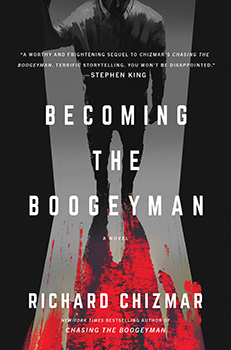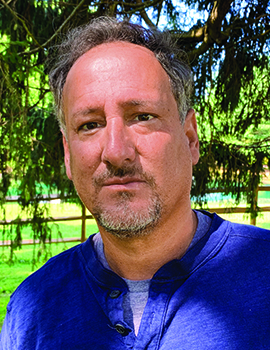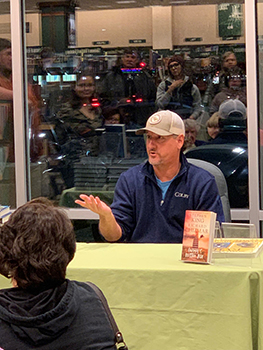

Features Richard Chizmar
The Heart of Horror: Richard Chizmar on BECOMING THE BOOGEYMAN
The Big Thrill Interviews Richard Chizmar
 Richard Chizmar created a sensation with Chasing the Boogeyman (2021) by blurring the lines of real and imagined in a novel that read like a true crime thriller. An amalgamation of fact and fiction, the book drew on the author’s own small-town upbringing and literary roots—indeed, Chizmar is the story’s unwitting protagonist—while adding fabricated elements such as a serial killer stalking the streets of his hometown. The result was a deeply nostalgic creation with ripped from the headlines vibes.
Richard Chizmar created a sensation with Chasing the Boogeyman (2021) by blurring the lines of real and imagined in a novel that read like a true crime thriller. An amalgamation of fact and fiction, the book drew on the author’s own small-town upbringing and literary roots—indeed, Chizmar is the story’s unwitting protagonist—while adding fabricated elements such as a serial killer stalking the streets of his hometown. The result was a deeply nostalgic creation with ripped from the headlines vibes.
Intended as a standalone, enthusiastic word of mouth quickly sent the book up the New York Times and USA Today bestseller lists, solidifying its status as a cult classic. Readers demanded more, and a fortuitous epiphany led the author to acquiesce. Consequently, October sees the release of BECOMING THE BOOGEYMAN—a contemporary (and equally self-referential) tale in which Chizmar once again finds himself at the center of a mystery when a series of apparent copycat crimes hit uncomfortably close to home. And this time, his wife and children are also in the crosshairs. Can he finally put the Boogeyman to rest, or will its legacy of evil live on?
Recently, Chizmar—also the founder of Cemetery Dance Publications—took time to discuss the surprising resonance of his Boogeyman books, which he credits to their melding of horror with heart. He also reflected on his friendship with (sometimes collaborator) Stephen King, shared spooky season reading recommendations, and offered a tantalizing glimpse of his next novel, the idea of which has been haunting him for years.
BECOMING THE BOOGEYMAN is the unintended sequel to Chasing the Boogeyman. Tell us how the reader response to that first book led you to reconsider your intentions. What was the process like for determining how to take a standalone story and spin it into an ongoing saga?
The response to Chasing the Boogeyman was such a pleasant surprise for me. Readers seemed to really connect with the nostalgic aspect of the story. Not only the coming-of-age sections involving my neighborhood friends and our small-town misadventures, but also the role that my immediate family played in the novel. “A serial killer novel with heart” (or words very similar to that) were used over and over again to describe the book. For such a personal story to resonate with readers was a dream come true.
The sequel, BECOMING THE BOOGEYMAN, exists for one reason and one reason only: I was mowing the lawn one afternoon and the idea for the first chapter came to me full blown. Every detail was in place, all leading up to the shock revelation that takes place at the conclusion of that opening chapter. By the time I finished cutting the grass, I knew I had to write it.
The books contain many autobiographical elements—and your family is prominently featured in BECOMING THE BOOGEYMAN, which takes place in a contemporary timeline (whereas the first book was set largely in the late 80s). How do you think this blurring of fact and fiction enhances the reading experience—and did you have any reservations about depicting your wife and sons (or yourself, for that matter) as characters about whom readers may make assumptions or judgments or feel a false sense of connectedness to?
I didn’t have any reservations about including family and friends and real-life events in the book—and my friends all loved having their stories told—but my wife, Kara, sure didn’t like it! She’s very much a behind the curtains kind of person, she doesn’t like the spotlight at all, so it took some convincing on my part—especially when it came to BECOMING THE BOOGEYMAN (where she plays a much larger role). I never set out to intentionally write the first book in that fashion, it sort of just happened. I originally started writing the introduction from the POV of a nameless narrator whose small town had been invaded by a killer…but by the time I was three or four pages in, I knew the story was about me and my hometown of Edgewood. Once I made that discovery, the words practically flew onto the page.
When it came to BECOMING THE BOOGEYMAN, I knew from Day One that I wanted to “play it straight” and continue with the same style of storytelling from the first book. Honestly, it was the only way I knew how to tell the story.
I think writing about a place, a period of time, and a bunch of people who meant so much to me lent the story a genuine sense of believability and allowed the reader to experience the terror in a more personal manner once it was introduced. They were invested in, not only the storyline, but the characters involved. They really cared about what happened to me and my friends and family.
The books’ small-town, close-knit settings are inspired by real-life communities that you know well. How do you see place as amplifying plot—and what do you hope your renderings convey about the formative experiences of youth (and their hold over us, even into adulthood)?
I originally started writing the introduction from the POV of a nameless narrator whose small town had been invaded by a killer…but by the time I was three or four pages in, I knew the story was about me and my hometown of Edgewood.
See directly above for the answer to the first part of this question! As writers, we’re always striving to create believable settings that readers can connect and identity with. I grew up as—and still am—a huge Stephen King fan. One of the things that attracted me so much to his stories was the way he depicted small New England towns. I was raised much farther south in Maryland, but I still intimately knew the kind of towns he was writing about. I knew their geography, their people, and their secrets. In my eyes, Maryland wasn’t so different than Maine. It still isn’t.
I’m a big sap when it comes to nostalgia. I was very fortunate. I had a wonderful childhood surrounded by amazing friends and family. Every day was an adventure. Some of the absolute coolest feedback I received from folks was in the form of “thank yous” for reminding them about the magic of their own childhoods. Moments in time and experiences that they had somehow forgotten. Many of them were surprised to read—and recall their own similar memories—about me and my friends popping hot tar bubbles in the street or having crab apple battles with gangs of kids from the next block over or jumping ramps on bikes. Going in, I never expected this kind of response, yet these messages ended up being some of my favorite interactions from readers.
You meld traditional narrative with epistolary elements (such as news articles and interview transcripts) and even photographs, which not only provide context but vary the storytelling presentation. How did you go about assembling these parts so that they would work together as a cohesive whole vs. detracting from one another—and was this something that was pre-planned or developed organically (or some combination of the two)?
I knew from the very beginning that I wanted to include photographs in both Chasing the Boogeyman and BECOMING THE BOOGEYMAN. For me, they were an integral part of the story and a huge key to getting the reader to suspend disbelief. That’s why I also wanted them to appear at the end of each chapter instead of in a singular location in the book. I wanted the photos to visually reinforce what the reader just finished digesting via words. I adore epistolary storytelling. It’s like putting together a puzzle and making sure the differently shaped pieces fit properly. It also adds some variety and requires the reader to look at the story from unusual angles. I like that.
You are a true-crime junkie. Despite having used the lens of fiction, what did you hope to capture about the realities of crime and consequences—and in what ways did pairing the Richard Chizmar “character” with the original Boogeyman killer allow for an exploration of such darkness?
I found myself—in both books—struggling with the obsession that so many of us readers and viewers have with violent crime and tragedy. As a result, that storyline became a significant focus of BECOMING THE BOOGEYMAN, and it brought up some troubling questions. First and foremost, as creators who deal with the dark side of human nature, how responsible are we for feeding into—and perhaps even inspiring—those people who embrace their dark sides and commit these horrible crimes? I tried to be very honest with readers, even when it didn’t necessarily shine a positive light on myself, and I think they will recognize that when they turn the pages.
You’ve had the great fortune of not only developing a friendship with Stephen King but an ongoing creative partnership (The Gwendy Trilogy). What are the most important things you’ve learned from him—both in terms of craft itself and being a member of the collective reader/writer tribe?
I think the most important thing I’ve learned from Steve is to trust myself. To trust that I have a story to tell that readers will want to engage with. Also, that it’s okay to tell that story in whatever style or format I feel is necessary. I’m not a very stylistic or literary-minded writer. I don’t tend to reinvent the wheel when it comes to my plotting. At my best, I’m an old-fashioned storyteller who writes campfire tales. Steve helped me understand that ultimately it’s the story that matters, not necessarily who tells it.
Other than that, it’s all the usual stuff. Cut the damn adverbs. Show, don’t tell. Go where the story takes you. It’s funny…we don’t talk writing or process very often. Usually it’s about baseball, family, books, and movies. And our dogs, of course.
Halloween season is upon us, which is a time when many readers like to catch up on their spooky reading. For those who enjoy the Boogeyman books, what authors/titles would you recommend for further exploration?
Goodness, there are so many! Steve King’s new one, Holly, is a killer. You can’t go wrong picking up the latest from C.J. Tudor, Michael Koryta, Linwood Barclay, Riley Sager, Christopher Golden, Caroline Kepnes, Philip Fracassi, Alma Katsu, and so many others. I could go on listing them for pages.
Leave us with a teaser: What comes next?
I’m wrapping up a dark novel called Memorials. It’s a road trip story featuring a trio of college students working on a class project. It’s set in 1983 and involves those roadside memorials that often pop up following fatal accidents. It’s an idea I’ve been carrying around for a lot of years, and it was finally time to write it down.
The Big Thrill Interviews Richard Chizmar
- LAST GIRL MISSING with K.L. Murphy - July 25, 2024
- CHILD OF DUST with Yigal Zur - July 25, 2024
- THE RAVENWOOD CONSPIRACY with Michael Siverling - July 19, 2024


